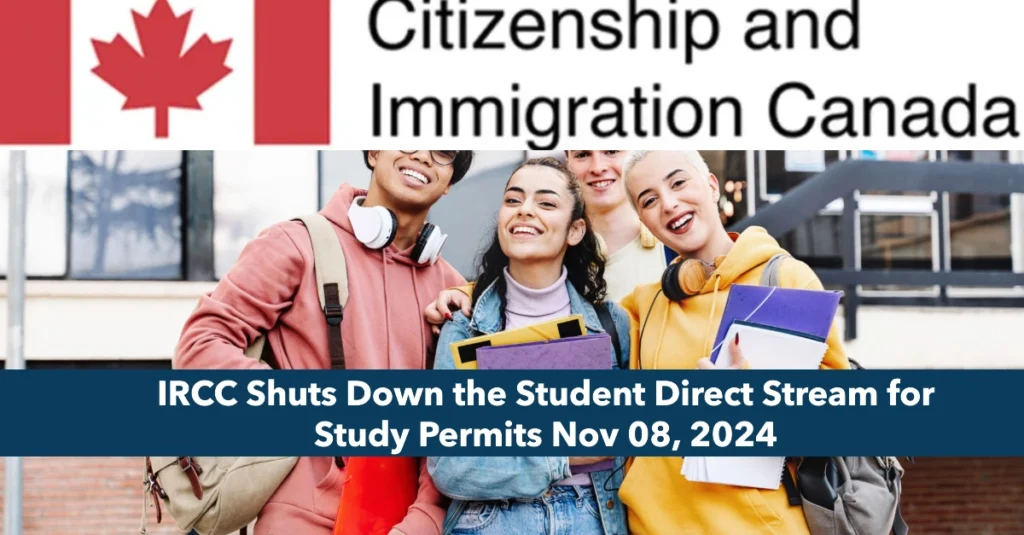In a surprising and significant policy shift, Immigration, Refugees and Citizenship Canada (IRCC) has announced the immediate closure of the Student Direct Stream (SDS), which has been in place since 2018 to expedite study permit applications. As of November 8, 2024, study permit applications will no longer be accepted under this fast-tracked stream. Going forward, all international students must apply using the standard study permit application process.
What Was the Student Direct Stream?
The SDS was introduced in 2018 to offer faster processing times for study permit applications from select countries, including India, China, Pakistan, the Philippines, and 10 others. This program significantly benefited students by offering expedited approval times, provided they met stringent criteria such as submitting proof of a Guaranteed Investment Certificate (GIC) worth $20,635 CAD and meeting language proficiency requirements.
Historically, the SDS had higher approval rates and a reputation for efficient processing. Its termination marks a considerable change for students who had relied on this streamlined pathway to enter Canada.

What This Means for Prospective International Students
The closure of the SDS will lead to longer and more uncertain processing times for all incoming international students. While SDS applicants previously enjoyed a swift and predictable process, those applying for study permits now must brace for delays. Average processing times under the regular study permit process vary widely depending on the applicant’s country of origin. For example, as of today, applications from India are taking around 8 weeks.
International students are now advised to start their study permit applications much earlier to account for these longer processing timelines and avoid any disruptions to their academic plans.
Prediction: What To Expect from Next Express Draw, All We Know So Far
Impact of New Immigration Targets on Express Entry Draws in 2025
3 Ontario PNP Streams Aligned with Express Entry
Top 10 Universities in Canada 2025: New List of Leading Institutions
Ontario to Restrict International Medical Students by 2026: Key Impacts and Goals
Understanding the Reasons Behind the Policy Change
The termination of the SDS aligns with broader changes to Canada’s international student program aimed at controlling the influx of temporary residents, which includes both study and work permit holders. In 2024, the federal government rolled out several measures to manage these levels, reflecting a strategic shift in how Canada handles its international student population.
The decision to close the SDS comes amid growing concerns about housing shortages, strained urban infrastructure, and the challenges associated with accommodating a rapidly increasing population of temporary residents. The government’s focus now appears to be on balancing economic benefits with sustainable growth and quality of life in major urban areas.
Canada Reduces Immigration Targets for 2025-2027 & Shift Towards Sustainable Growth
Key Implications and Next Steps
- Longer Processing Times: Students should expect delays and plan to submit their applications well in advance of their intended start dates. Given the discontinuation of expedited processing, applicants will need to adjust their timelines and prepare for a more rigorous application experience.
- Standard Application Requirements: Moving forward, all applicants will be evaluated under the regular study permit guidelines. This process may involve additional documentation and stricter scrutiny, impacting approval rates and the overall applicant experience.
- Financial Preparedness: The requirement for a GIC under SDS was a critical part of financial planning for students. While this requirement no longer applies, applicants will still need to demonstrate adequate financial resources to cover their education and living expenses in Canada.
- Adaptation and Strategy: Educational institutions and students may need to adapt quickly to this new landscape. Universities, colleges, and international student support organizations will likely increase their efforts to assist students in navigating the standard application process.
Final Thoughts
The closure of the Student Direct Stream represents a major shift in Canada’s approach to managing its international student population. While the SDS provided a reliable pathway for students from key countries, its discontinuation underscores the government’s efforts to control temporary resident numbers while still attracting high-quality international talent.
International students and stakeholders in the education sector will need to remain informed and proactive to adjust to these new requirements and maintain Canada’s reputation as a top destination for global academic opportunities.
